
AutoCAD 2005 For Dummies (2004)
.pdf
350 Part IV: Share and Share Alike
Table 16-1 (continued)
Feature |
Description |
Comments |
Where You Can |
|
|
|
Find More Info |
Insert |
Add hyperlinks to |
Of questionable |
“Hand-y objects” |
hyperlink |
objects in drawings |
use, except in |
in this chapter |
|
|
specialized |
|
|
|
applications |
|
Password |
Requires a password |
Useful for limiting |
“The Drawing |
protection |
in order to open a |
access to sensitive |
Protection |
|
drawing |
DWG or DWF files |
Racket” in this |
|
|
|
chapter |
Digital |
Provide electronic |
Requires an |
“The Drawing |
signatures |
confirmation that |
account with a |
Protection |
|
someone has |
digital certificate |
Racket” in this |
|
approved a particular |
provider; new |
chapter |
|
version of a |
technology, so look |
|
|
particular drawing |
before you leap — |
|
|
|
and talk to your |
|
|
|
attorney first |
|
|
|
|
|
Sending Strategies
E-mail and FTP (File Transfer Protocol) have largely replaced blueline prints, overnight delivery, floppies, and higher capacity disks as the standard means of exchanging drawings. Some companies even use specially designed Webbased services, such as Autodesk’s Buzzsaw, as a repository for project drawings from all the companies working on a particular project. Whether you’re exchanging drawings in order to reuse CAD objects or simply to make hardcopy plots of someone else’s drawings, you need to be comfortable sending and receiving drawings electronically.
Sending and receiving DWG files doesn’t differ much from sending and receiving other kinds of files, except for the following:
DWG files tend to be bigger than word processing documents and spreadsheets. Consequently, you may need to invest in a faster Internet connection, as described earlier in this chapter.
You can easily forget to include all the dependent files. I tell you in the next section how to make sure that you send all the necessary files — and how to pester the people who don’t send you all their necessary files.

Chapter 16: Drawing on the Internet 351
It’s often not completely obvious how to plot what you receive. Read Chapter 12 and the section, “Bad reception?” in this chapter to solve plotting puzzles.
Whenever you send DWG files together, follow the Golden Exchange Rule: “Send files unto others as you would have them sent unto you.” That means sending all the dependent files along with the main DWG files, sending plotting support files (CTB or STB files — see Chapter 12), and including a description of what you’re sending. And ask the recipient to try opening the drawings you send them right away, so you both have more time to respond if there’s any problem.
Send it with ETRANSMIT
Many people naively assume that an AutoCAD drawing is always contained in a single DWG file, but that’s often not the case. Each drawing file created in AutoCAD can contain references to other kinds of files, the most important of which are described in the following table. Thus, before you start exchanging drawings via e-mail or FTP, you need a procedure for assembling the drawings with all their dependent files.
Description |
File Types |
Consequences if |
Where the Use of |
|
|
Missing |
These File Types is |
|
|
|
Explained |
Custom font |
SHX, TTF |
AutoCAD substitutes |
Chapter 9 |
files |
|
another font |
|
Other drawings |
DWG |
Stuff in the main |
Chapter 13 |
(xrefs) |
|
drawing disappears |
|
Raster graphics |
JPG, PCX, TIF, |
Stuff in the drawing |
Chapter 13 |
files |
and so on |
disappears |
|
Plot style tables |
CTB, STB |
Lineweights and |
Chapter 12 |
|
|
other plotted effects |
|
|
|
won’t look right |
|
As you can see from the table, the consequences of not including a custom font aren’t that dire: The recipient still will see your text, but the font will be different. Of course, the new font may look odd or cause text spacing problems within the drawing. If, on the other hand, you forget to send xrefs or raster graphics that are attached to your main drawing, the objects contained on those attached files simply will be gone when the recipient opens your drawing. Not good!
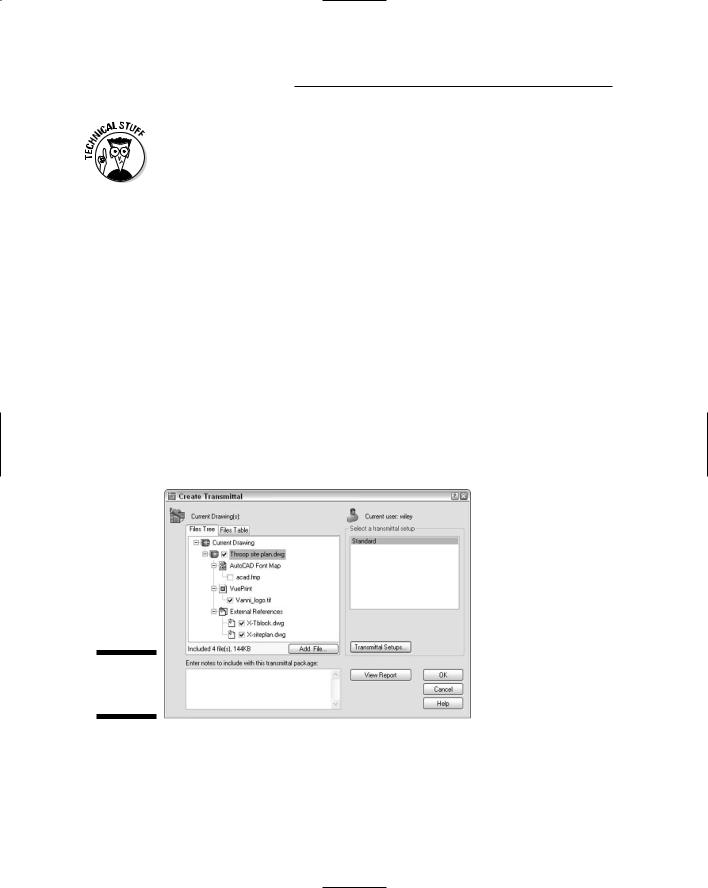
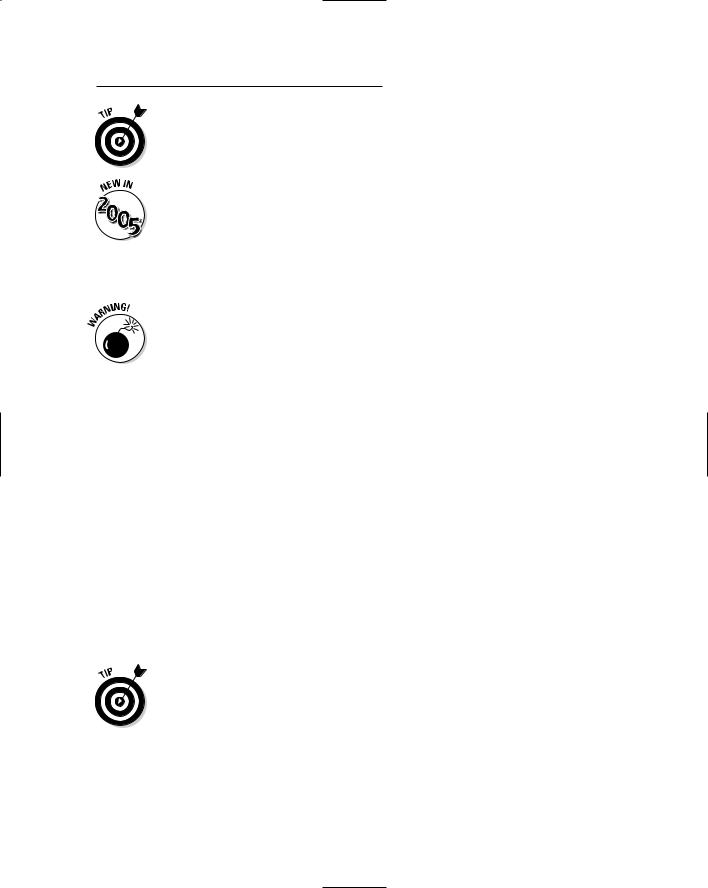
Chapter 16: Drawing on the Internet 353
Unless you have assigned custom font mapping, you can omit the
Acad.fmp file.
4.Select a transmittal setup from the list.
Transmittal setups are new in AutoCAD 2005. They contain settings that control how ETRANSMIT processes the drawings and creates the transmittal package. Click the Transmittal Setups button to create new or modify existing setups. The default Standard transmittal setup works fine for many purposes, except that you probably want to turn on the Include Fonts setting, as described in the next paragraph. In any case, you should view the settings (click the Modify button) just to see what options you can change if you need to later.
If you want AutoCAD to include SHX and TTF font files, including any custom fonts that you’re using, you must turn on the Include Fonts setting in the transmittal setup. (Click Transmittal Setups, click Modify, and check the Include Fonts box.) Note, however, that many SHX and TTF files are custom fonts, which work like licensed software. Sending them to others is just like sharing your AutoCAD program CD with others. No, I don’t mean that it’s easy and fun; I mean that it’s illegal and unethical. Before you send a custom font file to someone else, find out what the licensing restrictions are on the font and be prepared to work within them.
5.Click the View Report button.
You see a report listing the files that ETRANSMIT will copy, along with warnings about any files that it can’t locate.
6.Review the report and make sure that ETRANSMIT was able to find all the files.
7.Click OK.
ETRANMSIT displays a file dialog box so that you can specify the name and location of the transmittal package (which is a ZIP file by default).
8.Click Save.
ETRANSMIT creates the transmittal package (which is a ZIP file by default).
Although AutoCAD 2005 automatically compresses its DWG files, zipping files manages to compress them even further (about 20 percent more, in my experience). More importantly, zipping creates a single, tidy package of all your DWG, raster image, plot style table, and font files. No one likes to receive an e-mail message carrying an endless cargo of attached files. Do everyone a favor: be hip and zip.
The only downside to zipping is that creating a zipped file and extracting files from it require a separate zip/unzip program. Several good shareware utilities are available, including WinZip (www.winzip.com).
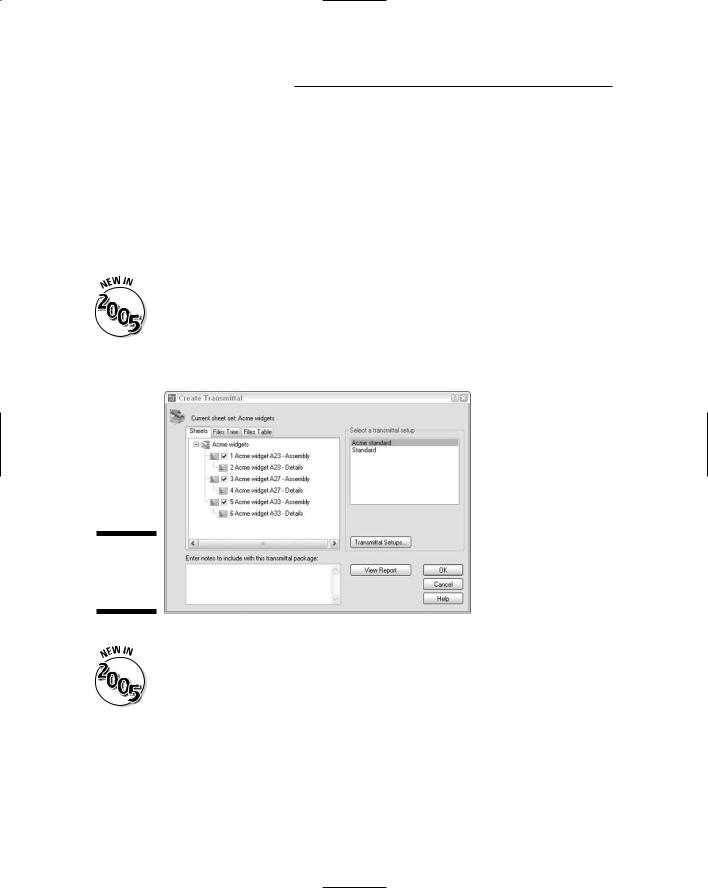

Chapter 16: Drawing on the Internet 355
FTP for you and me
FTP, or File Transfer Protocol, is a simple but robust protocol for copying files over the Internet. A computer that’s connected to the Internet can act as an FTP server, which means that part of its hard disk is accessible over the Internet.
The person who configures the FTP server can place restrictions so that only people who enter a particular logon name and password can see and download files. FTP overcomes the file size limitations that often occur with e-mail.
Because of all these FTP benefits, it’s increasingly common for people at larger companies to place drawing files on their company’s FTP site and tell you to go get them. This approach relieves them of having to e-mail you the files, and relieves you of waiting for that 10MB e-mail download when you least expected it.
In most cases, the person making the files available to you via FTP will send you a Uniform Resource Locator (URL) that looks like a Web page address, except that it starts with FTP:// instead of HTTP://. If you open your Web browser and enter the FTP URL into the address field, the browser should connect to the FTP site, ask you for a location and name to use for the file when it gets copied to your system, and begin downloading the file. If the FTP site uses password protection, you’ll have to enter a logon name and password first.
If you want fancier FTP download options, you can use an FTP utility program such as WS_FTP (www.ipswitch.com).
Even if you work for a small company, you may be able to post files on your ISP’s FTP server in order to make them available to others. Check with your ISP to find out whether you can do it and, if so, what the procedures are.
FTP transfers are more prone to user confusion problems than are e-mail files, especially if the recipient hasn’t used FTP before. For example, it’s common for the person posting the files to forget to tell the recipient the logon name and password, or for the recipient not to have an FTP program — or to not know how to use it. Check with your recipient the first couple of times you use FTP to transfer files to make sure they got the files successfully — and don’t be surprised if they ask you to use e-mail or overnight delivery instead.
Bad reception?
Other sections in this chapter focus on sending files to others. What happens when you’re on the receiving end? Not everyone will be as conscientious as you are about following the Golden Exchange Rule. You’ll receive drawings with missing dependent files and no information or support files for plotting.
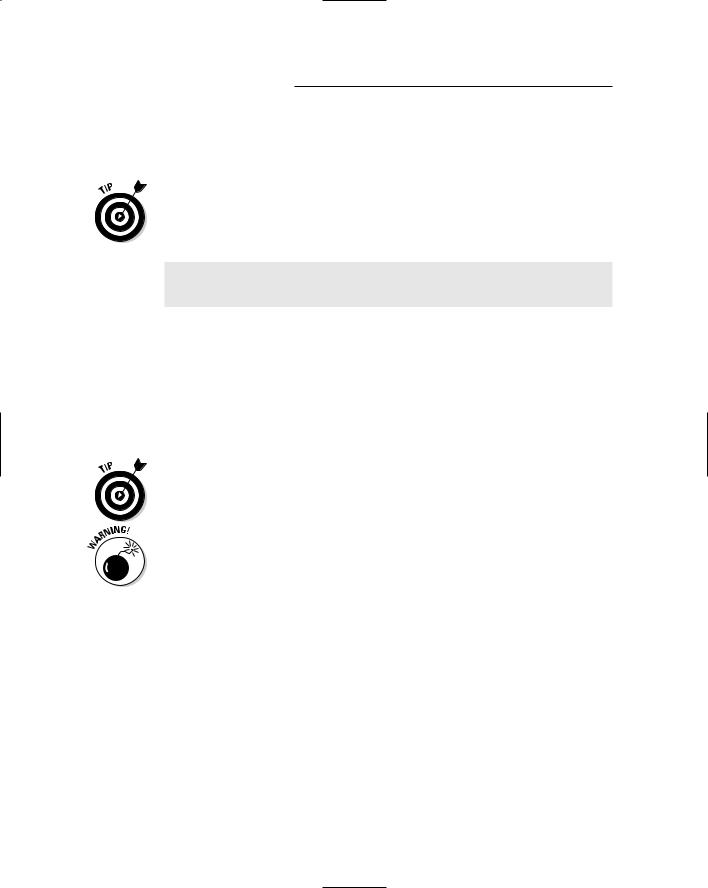
356 Part IV: Share and Share Alike
When you receive an e-mail message or FTP download containing drawings (zipped, I hope!), copy the file to a new folder on your hard disk or a network disk and unzip the files.
Check at least a few of the drawings in the package to make sure that all the xrefs, fonts, and raster image files were included. You can perform this check by opening each main drawing in that folder. After you open each file, press the F2 key to view the command line window, and look for missing font and xref error messages of the following sort:
Substituting [simplex.shx] for [helv.shx].
Resolve Xref “GRID”: C:\Here\There\Nowhere\grid.dwg
Can’t find C:\Here\There\Nowhere\grid.dwg
A Substituting. . . message indicates AutoCAD couldn’t find a font and is substituting a different font for it. A Can’t find. . . message indicates that AutoCAD couldn’t locate an xref. Any missing raster files appear as rectangular boxes with the names of the image files inside the rectangles. Alternatively, you can open the Xref Manager or Image Manager dialog box, which reveals any missing xref or raster image files. (See Chapter 13 for details.)
Write down each missing file and then tell the sender to get on the ball and send you the missing pieces. While you’re at it, tell that person to buy this book and read this chapter!
Press the F2 key after opening any drawing that you didn’t create so that you know right away if any fonts and xrefs are missing.
If you receive drawings with custom TrueType font files (files whose extensions are TTF), you must install those files before Windows and AutoCAD will recognize them. Choose Start Settings Control Panel. (In Windows XP, choose Start Control Panel and then click the Switch to Classic View link in order to see the Fonts applet.) Double-click the Fonts icon to open the Fonts window, and then choose File Install New Font.
Help from the Reference Manager
In Chapter 13, I warn you about the complications of xref paths and the potential perils of AutoCAD not being able to locate xrefs if you move project folders around or transfer drawings to or from someone else. A similar danger exists for raster image files (Chapter 13) and font files (Chapter 9). The ETRANSMIT
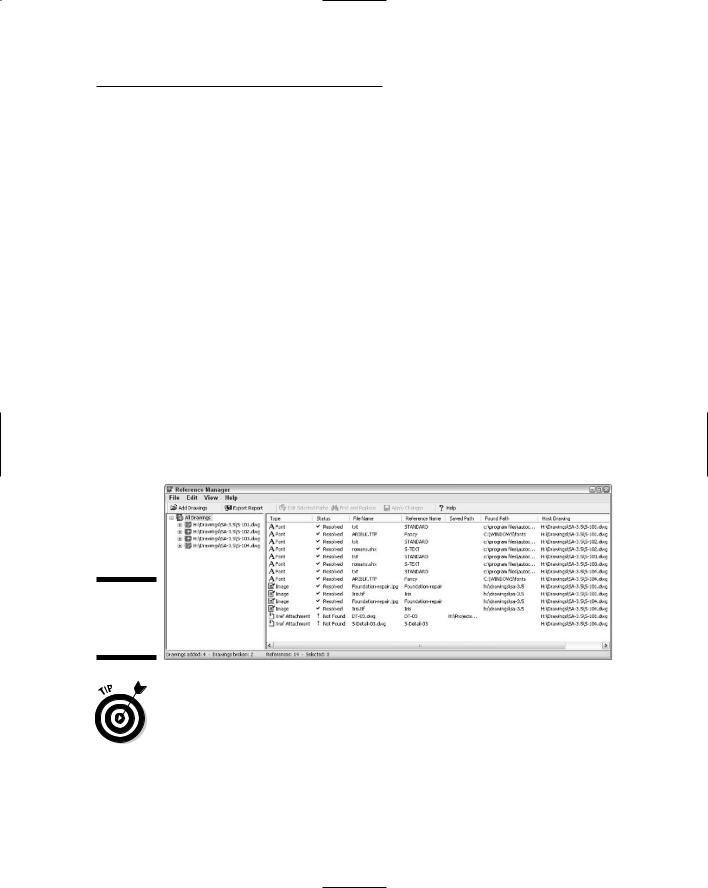

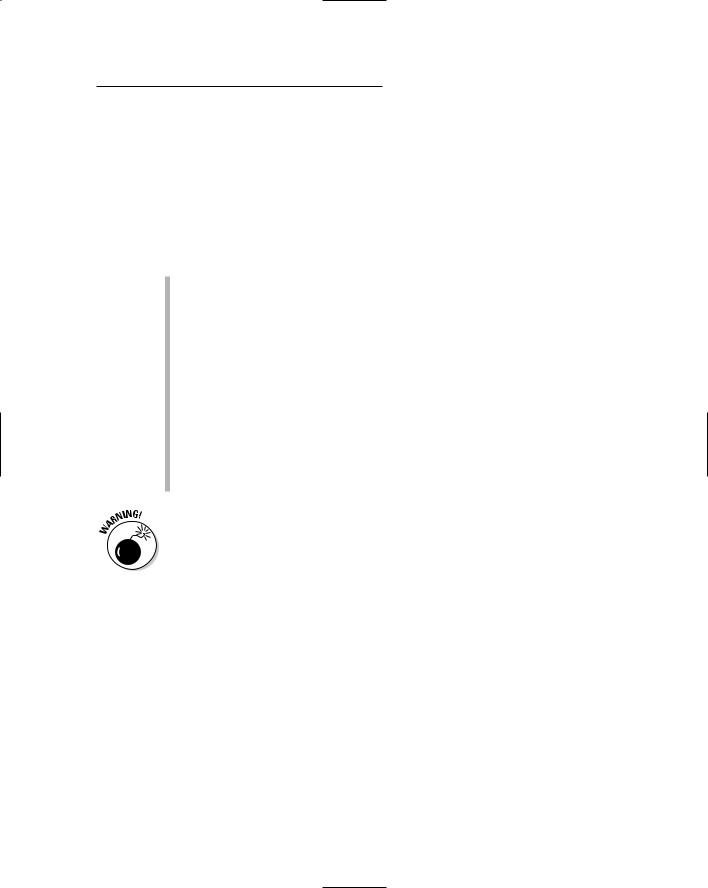
Chapter 16: Drawing on the Internet 359
ePlot, not replot
A DWF file captures a single, plotted view of your drawing, so, unlike a DWG file, it can provide a relatively unambiguous snapshot of what you want to see on paper. With a DWG file, on the other hand, you have to provide lots of information to other people — drawing view, scale, plot style settings, and so on — in order for them to get the same plotting results that you did.
Potential ePlotting scenarios include:
Architects and other consultants on a building project periodically upload DWF files to the project Web site. Architects and engineers with some minimal CAD knowledge can review the drawings on-screen and create their own hard-copy plots, if necessary. Principals and clients who don’t want anything to do with CAD, or even with computers, can have their secretaries or other employees create hard-copy plots for them to examine.
When Internet-savvy people need hard-copy prints of your drawings, you e-mail a zipped file containing DWF files, along with the URL for Autodesk Express Viewer and simple instructions for creating plots from the DWF files. (Be ready to walk them through the process by phone the first time or two to reduce anxiety on everyone’s part.)
A CAD plotting service bureau encourages its customers to send DWF files instead of DWG files for plotting. The DWF files are much smaller and require less intervention on the part of the service bureau’s employees.
The ePlot concept debuted in AutoCAD 2000 and hasn’t yet caught on in a big way. Autodesk hopes to establish ePlot and the DWF format as a standard for CAD documents similar to what Adobe’s PDF has become for word processing documents. It remains to be seen whether ePlotting will become a popular way to generate hard-copy output. In particular, many people outside of CAD-using companies don’t have access to large-format plotters. They’re limited to 81⁄2-x-11-inch — or, at best, 11-x-17-inch — reduced-size check plots. Consequently, many people won’t be able to plot your DWF files to scale, and may not even be able to plot them large enough to read everything.
Don’t be afraid to try ePlotting with colleagues inside or outside your company, but don’t become too dependent on it until you see whether the rest of the CAD world shares your enthusiasm. Otherwise, you risk becoming the only one who’s willing to use your DWF files for plotting — in which case the next version of the feature will be called mePlot.
